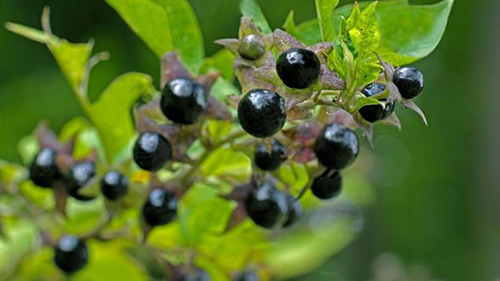Contents
The poisonberry plant belongs to the Solanaceae family, the same family as the potato, and both plants contain the same active component: solanine in their leaves and fruit.
This plant is native to the Americas, where ancient natives called it chichiquelite and used it in popular medicine. The Spanish conquerors introduced it to Europe, where it quickly spread.
Poisonberry Scientific Facts

- Scientific name: Solanum nigrum L.
- Other names: Deadly nightshade, garden nightshade.
- French: Herbe maure.
- Spanish: Hierbe mora.
- Environment: Common in warm areas of Europe and America, it grows in woods, by walls, and also in unfarmed lands.
- Description: The plant of the Solanaceae family grows from 10 to 30 cm high. The dark green leaves have irregular edges. The flowers are white, and the fruits are blackberries.
- Parts of the plant used medicinally: The leaves and the stem.
Solanum Nigrum Benefits

The green parts of this plant contain a glycoalkaloid: solanine, whose concentration increases with the average temperature of the climate in which the poisonberry grows. Solanine acts powerfully on the nervous system, provoking muscular relaxation, analgesia, and narcosis. It has antispasmodic, analgesic, and sudorific properties when taken internally, but the plant is currently only used externally because of its effects on the nervous system.
On the skin, poisonberry acts as a sedative and emollient substance. It is applied as lotions, compresses, or poultices, to alleviate pruritus (itching) on the vagina or the anus and to sedate the skin itching from scabies, ringworm, herpes, or any other type of rashes.
WARNING! The berries, sweet in taste, are poisonous, though they are not deadly.
DISCLAIMER: All content on this website is presented solely for educational and informational objectives. It would be best to not rely on the information provided as a replacement for advice, diagnosis, or treatment from a qualified medical expert. If you are pregnant, nursing, or have any preexisting medical concerns, you should talk to your doctor before using any herbal or natural medicines.

How to use poisonberry
- Lotions with the fresh juices of the leaves and stems.
- Compresses soaked in the fresh juice.
- Poultices with the leaves mashed.
REFERENCES
- George D. Pamplona-Roger, M.D. “Encyclopedia of Medicinal Plants.” George D. Pamplona-Roger, M.D. Encyclopedia of Medicinal Plants. Ed. Francesc X. Gelabert. vols. 2 San Fernando de Henares: Editorial Safeliz, 2000. 729. Print. [poisonberry plant]
- Wikipedia’s page on Solanum nigrum: https://en.wikipedia.org/wiki/Solanum_nigrum
- Kew Science’s Plants of the World Online, for botanical information: http://www.plantsoftheworldonline.org/taxon/urn:lsid:ipni.org:names:821953-1
- National Center for Biotechnology Information (NCBI) for scientific studies: https://www.ncbi.nlm.nih.gov/
